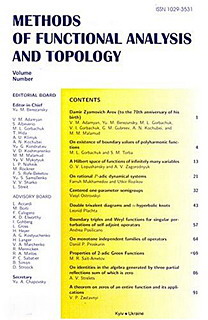Vol. 14 (2008), no. 2
The portrait of a young man (from memory)
MFAT 14 (2008), no. 2, 102-107
102-107
Recursion relation for orthogonal polynomials on the complex plane
Yu. M. Berezansky, I. Ya. Ivasiuk, O. A. Mokhonko
MFAT 14 (2008), no. 2, 108-116
108-116
The article deals with orthogonal polynomials on compact infinite subsets of the complex plane. Orthogonal polynomials are treated as coordinates of generalized eigenvector of a normal operator $A$. It is shown that there exists a recursion that gives the possibility to reconstruct these polynomials. This recursion arises from generalized eigenvalue problem and, actually, this means that every gene alized eigenvector of $A$ is also a generalized eigenvector of $A^*$ with the complex conjugated eigenvalue. If the subset is actually the unit circle, it is shown that the presented algorithm is a generalization of the well-known Szego recursion from OPUC theory.
Quasilinear parabolic equations with a Lévy Laplacian for functions of infinite number of variables
MFAT 14 (2008), no. 2, 117-123
117-123
We construct solutions to initial, boundary and initial-boundary value problems for quasilinear parabolic equations with an infinite dimensional Lévy Laplacian $\Delta _L$, $$\frac{\partial U(t,x)}{\partial t}=\Delta_LU(t,x)+f_0(U(t,x)),$$ in fundamental domains of a Hilbert space. The solution is defined in the functional class where a solution of the corresponding problem for the heat equation $\frac {\partial U(t,x)}{\partial t}=\Delta_LU(t,x)$ exists.
The direct and inverse spectral problems for (2N+1)-diagonal complex transposition-antisymmetric matrices
MFAT 14 (2008), no. 2, 124-131
124-131
We consider a difference equation associated with a semi-infinite complex $(2N+1)$-diagonal transposition-antisymmetric matrix $J=(g_{k,l})_{k,l=0}^\infty$ with $g_{k,k+N} \not=0$, $k=0,1,2,\ldots ,$ ($g_{k,l}=-g_{l,k}$): $\sum_{j=-N}^N g_{k,k+j} y_{k+j} = \lambda^N y_k,\ k=0,1,2,\ldots ,$ where $y=(y_0,y_1,y_2,\ldots )$ is an unknown vector, $\lambda$ is a complex parameter, $g_{k,l}$ and $y_l$ with negative indices are equal to zero, $N\in\mathbb N$. We introduce a notion of the spectral function for this difference equation. We state and solve the direct and inverse problems for this equation.
A stochastic integral of operator-valued functions
MFAT 14 (2008), no. 2, 132-141
132-141
In this note we define and study a Hilbert space-valued stochastic integral of operator-valued functions with respect to Hilbert space-valued measures. We show that this integral generalizes the classical Ito stochastic integral of adapted processes with respect to normal martingales and the Ito integral in a Fock space.
Douglis-Nirenberg elliptic systems in the refined scale of spaces on a closed manifold
MFAT 14 (2008), no. 2, 142-158
142-158
Douglis-Nirenberg elliptic systems of linear pseudodifferential equations are studied on a smooth closed manifold. We prove that the operator generated by the system is a Fredholm one on the refined two-sided scale of the functional Hilbert spaces. Elements of this scale are the special isotropic spaces of H\"{o}rmander--Volevich--Paneah. The refined smoothness of a solution of the system is studied. The elliptic systems with a parameter are investigated as well.
Inverse spectral problem for a star graph of Stieltjes strings
MFAT 14 (2008), no. 2, 159-167
159-167
We solve the inverse spectral problem for a star graph of Stieltjes strings (these are threads bearing a finite number of point masses) with the pendant ends fixed, i.e., we recover the masses and lengths of the intervals between them from the spectra of small transverse vibrations of the graph together with the spectra of the Dirichlet problems on the edges and the total lengths of the edges.
An exact inner structure of the block Jacobi-type unitary matrices connected with the corresponding direct and inverse spectral problems
MFAT 14 (2008), no. 2, 168-176
168-176
We discuss a problem posed by M. J. Cantero, L. Moral, and L.~Vel\'azquez about representing an arbitrary unitary operator with a CMV-matrix. We consider this problem from the point of view of a one-to-one correspondence between a non-finite unitary operator and an infinite (five-diagonal) block three-diagonal Jacobi-type matrix in the form of the corresponding direct and inverse spectral problems for the trigonometric moment problem. Since the earlier obtained block three-diagonal Jacobi-type unitary matrix has not been fully described, we continue this investigations in the present article. In particular, we show that this exact inner structure coincides with an earlier obtained CMV-matrix.
On solutions of parabolic and elliptic type differential equations on $(-\infty, \infty)$ in a Banach space
MFAT 14 (2008), no. 2, 177-183
177-183
We show that every classical solution of a parabolic or elliptic type homogeneous differential equation on $(-\infty, \infty)$ in a Banach space may be extended to an entire vector-valued function. The description of all the solutions is given, and necessary and sufficient conditions for a solution to be continued to a finite order and finite type entire vector-valued function are presented.
One-dimensional Schrödinger operators with singular periodic potentials
Vladimir Mikhailets, Volodymyr Molyboga
MFAT 14 (2008), no. 2, 184-200
184-200
We study the one-dimensional Schrödinger operators $$ S(q)u:=-u''+q(x)u,\quad u\in \mathrm{Dom}\left(S(q) \right), $$ with $1$-periodic real-valued singular potentials $q(x)\in H_{\operatorname{per}}^{-1}(\mathbb{R},\mathbb{R})$ on the Hilbert space $L_{2}\left(\mathbb{R} \right)$. We show equivalence of five basic definitions of the operators $S(q)$ and prove that they are self-adjoint. A new proof of continuity of the spectrum of the operators $S(q)$ is found. Endpoints of spectrum gaps are precisely described.


